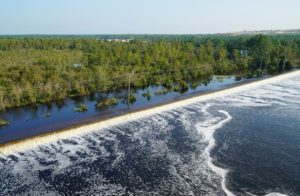
Is Prison Labor the Future of Our Food System?
A Concerning Trend that Needs to be Stopped Before it Takes Off
Over the past year, the Trump Administration’s crack down on undocumented workers, and harsh immigration policies has severely affected farm workers and farmers. Due to so many workers being detained or deported, farmers have had a severe shortage in workers. This has affected the harvesting of their products, leaving many farmers to lose money on rotten produce that can’t be sold. They have tried to bring in foreign seasonal workers, but the demand is too high.
Instead, to solve this problem many states, (like Maine, Georgia and Idaho to name a few), have

AUGUSTA, ME – OCT. 30: Kennebec County Correctional Facility inmates Ronald Moody II, left, and Anthony Williams pick potatoes on Tuesday September 30, 2014 in Augusta. Food grown by the Kennebec’s Restorative Community Harvest program is donated to schools and food banks. (Photo by Joe Phelan/Staff Photographer)
decided to use prisoners as farm laborers. Idaho already has six farms that use inmate labor, and they are looking to expand this with a new bill this year. The bill would allow inmates to work on farms if the farmers cannot find sufficient help. Prisoners do get paid, but less than half of what a normal worker would get paid. This is cheaper for farmers and corporations. They do have to pay the prison as well and that money goes to the inmate restitution program, and to pay for the inmate farm worker program itself. This is only a short-term resolution for the industry.
It is a concerning trend, because it is perpetuating a long time problem we have in our food system. We need to fix the broken immigration system with new laws allowing immigrants to legally come here to work. Instead, the government is turning back to a historical system of in-prisoned farm workers, not far from the conditions of slavery. Here is a great infographic explaining the prison-agricultural connection. In order to change this system around, we have to fight for fair wages, fair conditions, and better immigration policies. Using low paid inmates is not a solution!
The EPA Puts Head of Children’s Health Office On Leave
The Unexpected Move Shows Signs of Trying to Get Rid of the Office Altogether
Last Tuesday, the Head of the Environmental Protection Agency’s Office of Children’s Health Protection, Dr. Ruth Etzel, was placed on an unexpected administrative leave. Etzel joined the EPA in 2015 and has previous experience working on environmental health policy at the World Health Organization. She was apparently dismissed with no explanation, and asked to give in her badge and keys and cellphone.
This is a scary move, as the Office of Children’s Health Protection is a key player in making sure that environmental standards are safe for children throughout the country. Regulations protecting children are usually stronger because they are more vulnerable to pollutants than adults.
“To take away the badge and access from a top career official and shove them out the door is very rare,” said Christine Todd Whitman, who headed the E.P.A. under President George W. Bush. “If they’re not saying why they dismissed her, it creates the impression that it’s about the policies she worked on.” She described the children’s health office at the E.P.A. as “critical to the health of the future.”
Public health experts said that, since the start of the Trump administration, they had seen a clash between the E.P.A.’s top leadership, appointed by a president who has pushed for weakening environmental rules, and the children’s health office. The E.P.A. has reduced the size of other offices with mandates that sometimes clash with Mr. Trump’s anti-regulatory agenda, such as the Office of Environmental Justice, which is charged in part with protecting poor and minority populations from the health effects of pollution.”
This comes after there has been a lot of concern about the effects of the chemicals in many major pesticides. The major ones are glyphosate, which is a known carcinogen, and chlorpyrifos which has been linked to childhood brain cancer.
The Trump Administration has been looking to roll back regulations on pollutants in our country for the past year, and there has been some talk about the Children’s Office of Health Protection opposing this. Regardless, is it alarming to see top EPA officials being dismissed with no explanation, leaving the organization with less people to continue the work to keep us safe.
USDA Announces Disaster SNAP Benefits For Victims of Hurricane Florence in North Carolina
Hurricane Florence has left many North Carolina residents with severe flooding and no where to go. Many people have had to be evacuated to shelters because the flooding has left huge interstates flooded. In order to feed the population, the USDA has relaxed the guidelines for SNAP Benefits to provide people with food. This includes allowing people to use the SNAP Benefits on hot prepared food, usually not allowed. It also allows people who would not usually qualify for the program to receive benefits for one month, until they have recovered from the aftermath of the hurricane. This is part of a larger plan called the North Carolina Disaster Nutrition Assistance. To see all the counties, and programs that have been included click here.
To read the full USDA Press Release click here.
Coal Ash Basins Overflow With River Flooding in North Carolina
Toxic Chemicals from Coal Ash Waste Now Potentially Polluting the Cape Fear River in North Carolina
The aftermath of Hurricane Florence continues to affect our environment. Last week, as the rivers breached and floor waters rose, the Duke Energy L.V. Sutton power plant became flooded. The natural gas plant has at least 6 inches of water and had to be shut down. The major problem they are facing right now is the washing away of a huge coal ash waste basin. The waste basin has been breached by flood waters and coal ash waste has been washed away into the man made lake near by, Sutton Lake. Duke Energy estimated last week that 2,000 cubic yards of coal waste has been washed away, which is equivalent to 150 dump trucks of waste. The worst news yet, as of Friday, Sutton Lake had been breached allowing coal waste water to go directly into the Cape Fear River, which runs throughout the state of North Carolina.
“Pete Harrison, a staff attorney at the environmental law firm Earthjustice, went to the site of the spill Friday and traveled on the Cape Fear River by boat, along with a member of the clean-water advocacy group, Waterkeeper Alliance. He said water from Lake Sutton was “pouring out” into the river at several points.
Harrison said he and his colleagues saw plumes of water containing coal ash particles, some floating on the surface and some underneath. “These swirling plumes went on for miles, and we watched them form as they poured out of the lake,” he said.
Coal ash is what is left over after coal is burned in a power plant, and it contains heavy metals including arsenic, lead, mercury and chromium. The Sutton plant switched from coal to natural gas years ago, but the waste remains at the site. Farther inland, the company’s Lee power plant has three pits containing coal ash and covered earth and trees; heavy rains washed coal ash from those sites into the nearby Neuse River.”
The problem is that the plants are close to flood prone areas in coastal planes. The government needs to make stronger regulations on where plants with toxic waste can go, and move them away from flood prone areas! How can we feel safe when toxic chemicals are going into our water supply?




Comments are closed.